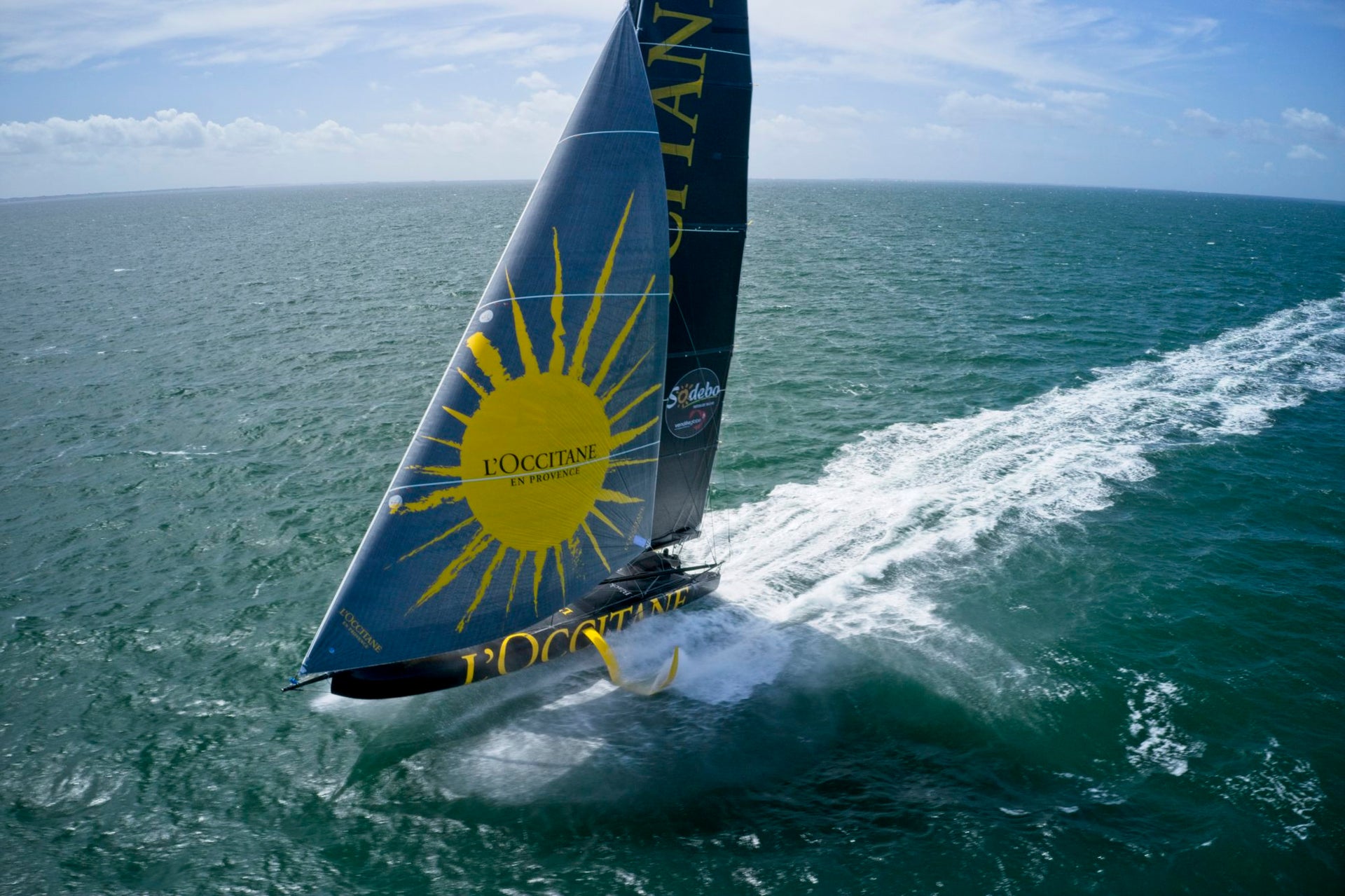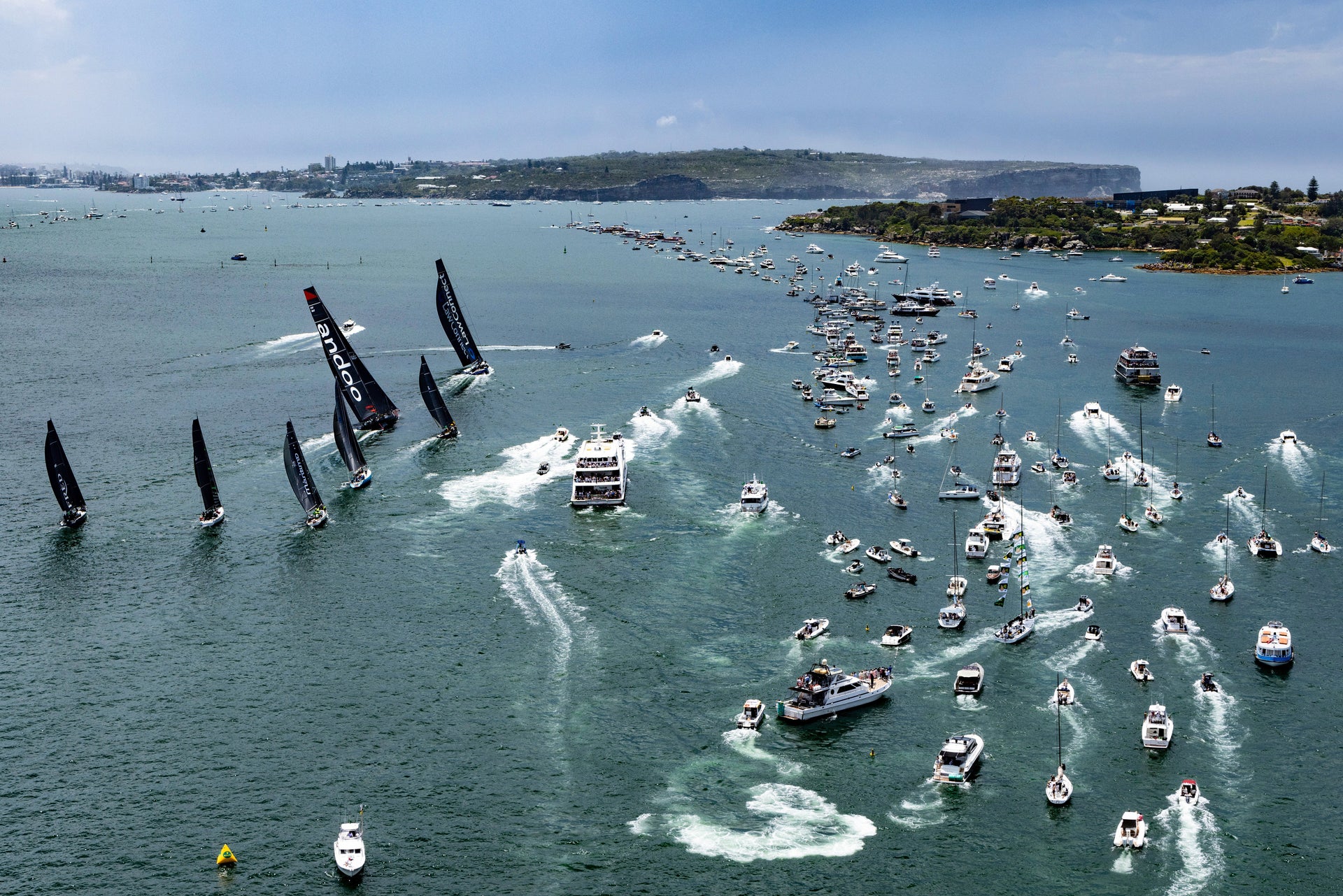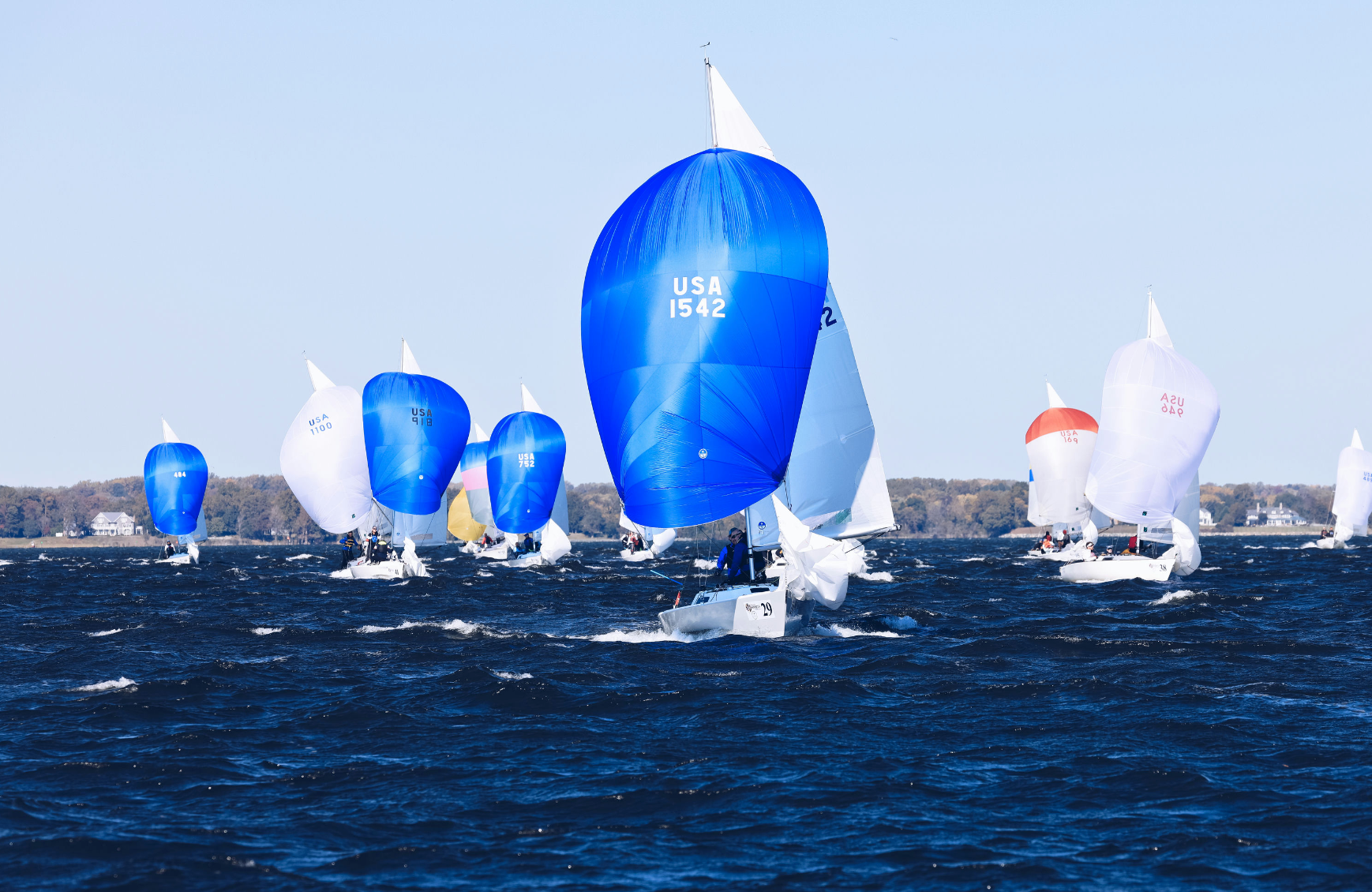IMOCA L'OCCITANE EN PROVENCE STANDS OUT FROM THE FLEET
L’OCCITANE EN PROVENCE: AN IMOCA THAT STANDS OUT FROM THE FLEET
Innovation Proves Vital For the IMOCA Class

L’Occitane en Provence, the first of its kind in many ways, proves innovation is vital for the IMOCA fleet. Skipper Armel Tripon and boat designer Sam Manuard give us their impressions on their new IMOCA L’Occitane en Provence from conception to the first sea trials.
Table of Contents:
Effective and Distinctive Design Downwind Performance Sail Design
From The Drawing to the First Sea Trials Mastering the Boat
Armel Tripon’s L’Occitane en Provence is one of the most recent boats in the latest generation IMOCA class. After two years of design and build, the yacht was launched last January in Nantes, France, the skipper’s hometown, but also the location of the Black Pepper Yachts shipyard where the foiling monohull, designed by the architect Sam Manuard, was built and equipped with a North Sails wardrobe.
“For me, it’s an incredible opportunity in my life as a sailor to be at the helm of this new boat,” says the 44-year-old skipper, Tripon. And what a boat! An IMOCA for a completely crazy race: the Vendée Globe.”
This will be the first solo around-the-world race for Armel Tripon, who won the Route du Rhum in 2018 in the Multi50 class. But it is also Sam Manuard’s first IMOCA Open 60 presented in the Vendée Globe and the first monohull in this class built by Black Pepper Yachts.
“This boat, which we wanted to be unique, has a genuine philosophy,” continues Armel Tripon. “It is a project that strongly reflects our aspirations. From the outset, our goal was to put together a new design team different in its way of thinking, which brings fresh ideas and is not afraid to think outside the box. This includes all the other partners: the shipyard and the sponsor who gave us the green light, convinced by the philosophy of our project.”
“This also represents a pivotal moment when the IMOCA class has opened up to the foil,” says the skipper. “We have entered a new era. It is magical to have taken part in this development, been an actor in these new IMOCA class rules, put the energy into designing this boat, and succeeded in getting everyone moving. It is a great success.”

Efficient and Distinctive Design
This state-of-the-art yacht with a scow hull design stands out from the rest of the IMOCA fleet as it is the only one designed with this round and wide bow shape. Why such a choice? Sam Manuard, a naval architect but also a professional sailor — a double role that allows him to better understand the boat’s reactions — explains that the idea was to limit detrimental stressors to the performance of both the boat and the skipper. Scow hulls are more tolerant,” he explains. “It has been noticed that with this shape, when the yacht moves with the sea, i.e., downwind, the bow buries less. When the boat fills with water, it is a source of stress for the sailor and, therefore, a barrier to human performance. We’ve tried to target a virtuous spiral where all the small factors go in the same direction to reduce both mechanical stress and that of the skipper.”
Downwind Performance
The concept of L’Occitane en Provence was based on two primary principles: first, to build a boat that the skipper can use, i.e., efficient in terms of performance, and second, to get a boat which can be pushed hard downwind and broad-reaching, particularly in heavy seas.
Sam Manuard develops: “According to these two key parameters, we have oriented our technical choices, and this is reflected in the scow hull, a particular mass balance, the distribution of ballasts, the foils which exit well above the waterline, good protection which includes, among other things, a cockpit very far aft and a roof enabling forward vision, etc. All these elements that are put together meet our initial postulates.”
In this design phase, specifies the architect, “we had many open discussions about all the key points of the construction with Armel and all the players involved in this project, Michel de Franssu, the founder of the Black Pepper shipyard, the various design (boat and sails), structural and technical teams. We had a free approach to proposing ideas, so everyone gave their opinion openly. As far as the sails are concerned, the North Sails design team led by Gautier Sergent has been in the loop from the first meetings. Gautier Sergent is extremely knowledgable of sail configuration and gave us valuable input on the chainplate position and deck plan, among other things.”
“He’s a talented designer who always queries the sailor for feedback and input, adds Armel Tripon. “He is very open-minded and not shy to think outside the box. I appreciated working with North and being able to rely on a competent team with great knowledge. With North Sails designer, Julien Pilate, they were involved in the entire project, both in the structure of the boat and the sails.
“The aim was to create a fast, balanced, reliable boat, high performance but could also be handled by a single skipper for 70 days,” says Gautier Sergent, North Sails Head of R&D Department. “We freely imagined an ideal concept based on collective expertise. It was refined and adjusted, leaving aside any preconceived ideas over the months of the design period. And Armel trusted us.”
After this first phase of brainstorming, another fundamental aspect of this project was the computing power: the aerodynamic efficiency of the sails and hydrodynamic simulation, which fed into the VPP.
“In this study, a lot of calculations and simulations were carried out for which North Sails managed all the aerodynamics,” says Sam Manuard.
This includes the overall aerodynamic drag and the interaction between the platform and the sails. “It’s a key parameter on foilers which are going faster and faster, and it has a big impact on the boat’s stability,” explains Gautier Sergent.

Sail design between stability and performance
However, IMOCA rules are restrictive. The challenge for the North Sails design team was to integrate specific constraints such as chainplate positions and rake while maintaining the balance of the boat by finding forgiving sail trims and configurations, etc.
As IMOCA boats do not have elevators on the rudders, the aim is to achieve the ideal ratio between the longitudinal position of the foil, the pitching moment of the sails, the shape of the hull, the boat state and other complex parameters.
“We’ve modeled various critical navigational cases which aim to define the maximum efforts that the sail plan will generate,” explains Julien Pilate. “This critical load information is then exchanged with the structural engineers, which enables them to correctly size not only the chainplates structure but also the structural elements of the hull. The use of the VPP is an essential tool for the sail designers, and in the development of a foil IMOCA, it allows us to determine the most efficient combination of sails in certain conditions, their surface area, and volume and therefore an ideal set of sails.”
“We’ll certainly be making some changes to some of the sails, but with minor modifications,” adds Sam Manuard. Downwind VMG sails have to be carefully considered. Should we choose a spinnaker or a gennaker, for example? The feedback from our training on the water will help us make up our minds. The selection limited to eight sails for the Vendée Globe will not necessarily be dictated by pure performance, but by a balanced set of compromises, depending on the number of maneuvers, for example. We must make decisions and then responsibility for them. The aim is for the boat to go fast without too much effort.”
From the Drawing to the First Sea Trials
From drawing plans and simulations to the first sessions on the water, Armel Tripon and his team are delighted.
“The first sailings have been positive,” comments Sam Manuard. As soon as the boat reaches its speed of stability, it sails exceptionally. The foils are working well; the sailboat in aerial mode is fast enough. It is almost thrilling. I was already lucky enough to sail on Jean-Pierre Dick’s IMOCA St Michell-Virbac where the sensations were superb, but with L’Occitane en Provence, you take it up a notch, the boat is airier, it’s another dimension.”
“I’ve spent hundreds of hours on the drawing board, thinking about many solutions for this yacht,” he continues. What interested me the most was to anticipate the boat’s dynamic reactions as well as possible. It is one thing to think and conceptualize and another to navigate. All in all, this is what we anticipated. The boat gets up; the movements are much smoother on the waves, we have gained in fluidity. It’s a great privilege and a chance to be able to design such a boat and be able to put our thoughts into practice on the water. »
Armel Tripon, who is very familiar with trimarans, observes that the sensations are similar to those of a multihull from 20 knots of speed, a real flying machine. Below this speed, the displacement takes over, and the boat’s behavior is like that of a typical keel monohull. However, maneuvers remain more physical on an IMOCA than on a multihull.
As for the deck and sail plans on L’Occitane en Provence, Armel observes that the ergonomics are well designed and fluidly executed. “The work was very rigorous on the sail adjustment, he says. It seems insignificant, but sometimes there can be small gaps. Here, the design twists naturally. It has met our expectations even beyond what I can see. We’re still in the detail phase, and it’s still too early to draw any real conclusions, but generally speaking, the sails’ design is very successful, even from the outside where we could see the sails from the zodiac boat and drone images as well.

Next Objectives: Mastering the Boat and Qualifying for the Vendée Globe
The next few weeks will be intense and will be devoted to making the boat more reliable. Besides, Armel will aim at passing his qualification for the Vendée Globe during the Arctic-Vendée race, which will start on 4th July in Les Sables-d’Olonne in France. “My next steps will be to learn how to control my boat in the best possible way, acquire as much data and knowledge as possible and then qualify for the Vendée Globe,” says Armel.
Sam will stay by his side through this training phase. “My role from now on will be to accompany Armel in his preparation for the Vendée Globe, and I will often be on board to check the boat’s settings. I’ll connect with him, share my thoughts.”
“Sailing a lot will allow us to test the reliability and stability of the boat, the maneuvers, the performance of the sails, etc. The big challenge remains the analysis of performance (with a lot of data to be recorded) and reliability,” summarizes Sam.
“It will be a question of finding the right balance between navigation and reliability of the boat, knowledge, and performance,” adds Armel. At each training session, we’ll have a specific goal. For example, if we focus on the use of sail, we will target more specifically its shape and think about how we can further refine it.”
Sea trials will be scheduled over several days off the coast of Brittany. With the start of the Vendée Globe on 8th November approaching, Armel feels ready. “I had an excellent preparation when the boat was under construction. Now we are getting to the heart of the matter, it’s good timing!”



























